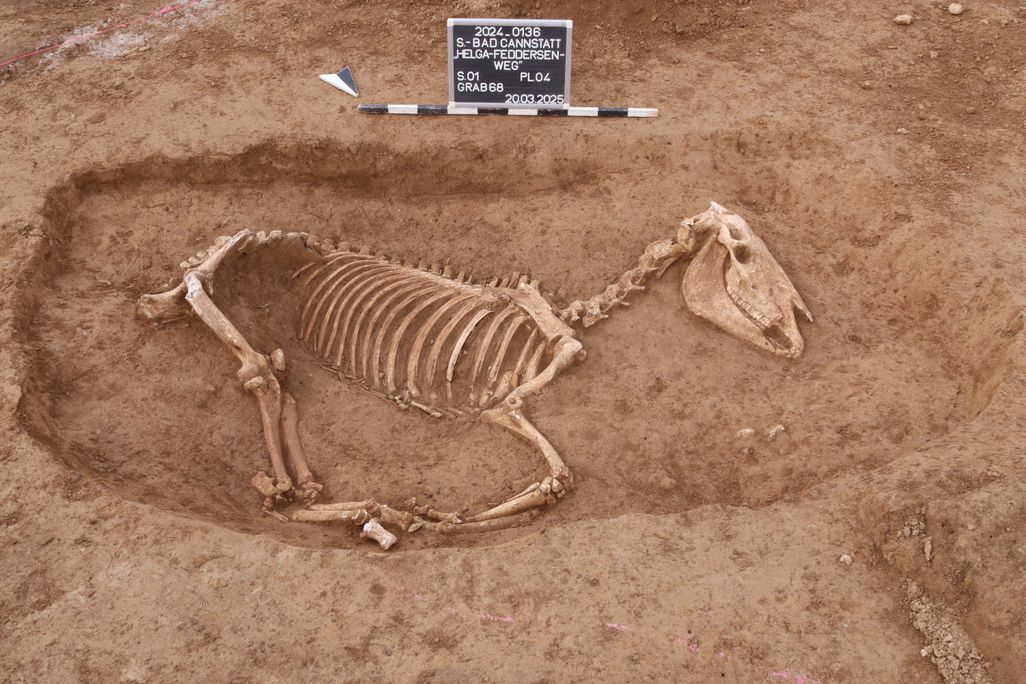1,800-Year-Old Horse Buried With Grave Goods Suggests Deep Bond Between a Roman Soldier and His Steed
1,800-Year-Old Horse Buried With Grave Goods Suggests Deep Bond Between a Roman Soldier and His Steed
Archaeologists were preparing for the construction of a new housing development when they found more than 100 equine skeletons dating to the second century C.E.
Archaeologists unearthed more than 100 equine skeletons near the site of a Roman military base.
State Office for Monument Preservation in the Stuttgart Regional Council / ArchaeoBW
Roughly 1,800 years ago, a Roman cavalry horse died of unknown causes. The animal’s human rider, a Roman soldier, buried the creature in a shallow grave. As a parting gift, the soldier tucked a few mementos into the crook of one of the horse’s legs: two jugs and a small oil lamp—“items commonly associated with human graves in Roman culture,” as the Greek Reporter’s Nisha Zahid writes.
That’s the scenario archaeologists say likely played out nearly two millennia ago in what is now southern Germany. They recently unearthed the equine skeleton and the accompanying grave goods while excavating a massive Roman horse cemetery in Stuttgart, according to a statement from the State Office for Monument Preservation of the Stuttgart Regional Council.
Researchers made the discovery last summer while preparing for the construction of a new housing development. In total, their excavations turned up more than 100 horse skeletons, which radiocarbon dating revealed were from the second century C.E.
One of the horses appears to have been buried with grave goods, which suggests the animal and its rider shared a deep bond.
State Office for Monument Preservation in the Stuttgart Regional Council / ArchaeoBW
The creatures were likely part of a Roman cavalry unit that was stationed in the area from roughly 100 to 150 C.E. At the time, the region was home to an important Roman military base.
Historians think the cavalry unit likely consisted of more than 700 horses and nearly 500 men. When the animals died, they were buried in a special area. The skeletons were found approximately 1,300 feet from the site of the cavalry fort.
Each horse appears to have been dragged into a shallow pit, then placed on its side. Some of the horses were buried with their legs bent, while others had their legs stretched out.
The horse that was buried with grave goods appears to be the exception, not the rule, as archaeologists didn’t find any others like it. The grave goods suggest the owner felt a very close bond with his steed.
“Even after about 1,800 years, the grief over the death of this one animal is still apparent,” Sarah Roth, the archaeologist in charge of the dig, says in the statement, per a translation from Popular Mechanics’ Tim Newcomb.
Archaeologists suspect Roman soldiers marked the location of each grave, because there was very little overlap between the horses’ burial sites.
Researchers were preparing the site for the construction of a new housing development in Stuttgart.
State Office for Monument Preservation in the Stuttgart Regional Council / ArchaeoBW
The horses did not die at the same time from some sort of major event, like a disease outbreak or a battle. Instead, it appears they died one at a time, probably from illnesses or injuries that prevented them from fulfilling their duties in the military. Archaeologists think that if a horse could still walk, it was likely led to the location of the cemetery and then euthanized on site, so that soldiers wouldn’t have to drag its heavy body.
The body of an adult man was also discovered among the horses. The man was found lying on his stomach, without any grave goods. He was “seemingly an ‘outsider’ buried with little care,” as All That’s Interesting’s Kaleena Fraga writes.
This is not the first time archaeologists have discovered equine remains in the area. As early as the 1920s, crews constructing residential buildings stumbled upon equine skeletons and began referring to the area as a Roman horse cemetery. (Coincidentally, Stuttgart means “a garden for the horses.” The city traces its origins back to a tenth-century stud farm.)
Archaeologists think they’ve only scratched the surface. They suspect the horse cemetery is larger than the area they’ve already excavated.
In the future, the researchers hope to study the remains to determine the horses’ sex, age, size, cause of death and overall health. They’d also like to learn more about how the Romans kept, fed and bred the animals.
Get the latest stories in your inbox every weekday.


